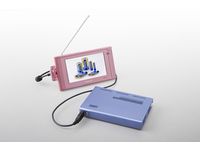Panasonic Unveils Notebook Fuel Cell
Panasonic announced it will showcase a new methanol fuel cell prototype this week that can output up to 20 W of power for 20hours.
The new fuel cell is half the size of the previous prototype that Panasonic had demonstrated in the past at CES 2006, offering a size that is now comparable to a traditional notebook battery pack. The new fuel cell can produce an average power output of 10 W, with a maximum output of 20 W, which can be sustained continuously for 20 hours on 200 cc of fuel.
There appears to be two different versions of this new fuel cell prototype; one for use in notebooks and a second for use as a battery charger. The notebook fuel cell has a volume of 270 cc, which it appears 200 cc of that volume is for the methanol fuel. The battery charger version has a larger volume of 360 cc, but it also seems to have a fuel capacity of 200 cc. The weight of each device without fuel is 320 grams and 350 grams, respectively. Referring to Wikipedia for the density of methanol, it would seem that with a full tank of fuel both fuel cells would each weigh just over one pound.
Panasonic will display the new fuel cell prototype at the Hydrogen Energy Advanced Technology Exhibition 2008 in Japan on Wednesday, with hopes of a commercial launch in 2012. Panasonic is not the only company with ambitions of commercializing fuel cells though, as Toshiba has already announced its hopes to release a fuel cell system in the coming months. Current availability of fuel cells is generally limited to the U.S. Army, although there are some fuel cell systems currently available for consumers.
Unlike with traditional batteries, fuel cells do not degrade over time or require recharging. As long as fuel is provided, power will flow continuously. With an average output of just 10 W of power though, these new fuel cells may only be enough to power energy-efficient mobile devices, such as netbooks, instead of traditional notebooks. Problems with government regulations, fuel distribution and costs are among some of the other issues that companies wishing to deploy fuel cells are facing.
Get Tom's Hardware's best news and in-depth reviews, straight to your inbox.
-
sgtbaker420 So what does this really mean for the end user? We cant get fuel for the fuel cell that we cant get, to charge a device that we don't yet have?Reply
I know I'm missing something here. -
AndyYankee17 so you're basically running your laptop with an engine? what the hell? so you want to use your laptop on a plane and you poison the flight crew with fumes?Reply -
godmode 20 hours of battery life sounds awsome but the real question here is how we gonna get our hands on methanol and how much will it will cost?Reply -
tntom I hope eventually they standardize these things like batteries are. For example: If you have rechargeable AA batteries you can put them in any camera that take AA batteries. Or you can buy one Size "A" Fuel Cell and keep it through multiple generations of laptops.Reply -
ceteras Replyfuel cells do not degrade over time
I thought the useful lifespan of fuel cell stacks is currently well below that of conventional technologies.
-
androticus Let's see... portable methanol fuel-cells have been promised for what... almost 10 years now? With "production models" always "less than 2 years" away, right????Reply

